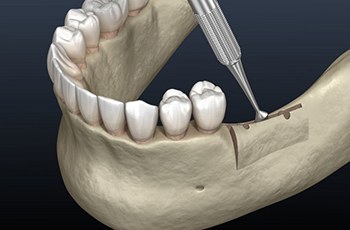Ridge Augmentation – Columbia, TN
Restoring Your Facial Shape & Bone Structure

Have you been missing teeth for some time? Did you recently undergo a tooth extraction? Regardless of when you’ve lost a tooth, it’s important to note that this typically results in changes in your jawbone due to a loss of stimulation where roots used to be. Instead of experiencing the consequences of tooth loss, such as bone resorption and dental shifting, you can undergo a ridge augmentation at our Columbia office! This procedure not only helps you preserve a more youthful facial shape, but it can also improve your chances of receiving dental implants or getting the best-fitted dentures. Keep reading to learn more about this treatment or reach out to us today to schedule a consultation.
What Is a Ridge Augmentation?

Whenever you lose a tooth root, the jawbone can begin to recede due to lack of stimulation and blood flow in the tissue. This can end up resulting in your facial shape shrinking over time as well as negatively affecting your jaw size and function. If you’re interested in getting dental implants or dentures but your jawbone is significantly altered, then you may have to replace lost bone tissue by undergoing a ridge augmentation. This procedure is designed to add extra or new bone material into the area where your jaw is weakest. Over time, the grafting substance should fuse with your jawbone, strengthening and improving its structure.
Why Might I Need Ridge Augmentation?

There are several reasons why a patient might require ridge augmentation before undergoing a dental implant or denture process. The most common ones include:
- Bone Resorption: Losing a tooth can lead to bone resorption, as the jaw won’t have adequate stimulation to promote bone growth. This can make it more difficult for your mouth to support dental implants.
- Structural Problems: Some patients might not already have a strong or thick enough jawbone to support implants, meaning they’ll have to enhance their facial structure with a ridge augmentation.
- Gum Disease: Bacteria that’s accumulated around your gums can end up attacking the jawbone tissues, causing them to become weak and shrunken. To reverse the impact of periodontal disease, a ridge augmentation may be necessary.
How Is a Ridge Augmentation Performed?

Firstly, our team will need to verify that your jawbone and mouth are free of any underlying issues such as decay and gum disease before starting any treatments. Once we’ve confirmed that you’re a good candidate for ridge augmentation, we’ll walk you through the entire process, including how to prepare for your visit, the details of the surgery, your recovery stage, and the cost of the procedure.
Before starting your surgery, our team will administer a local anesthetic so that you’re pain-free throughout your appointment. We might even provide you with sedation dentistry to remain as comfortable as possible. Your dentist will begin by making an incision in your gum line to expose the area of the jawbone that requires additional structure. After placing the bone material, we’ll suture the gums closed and you’ll be given instructions on how to care for your smile during your healing period.


